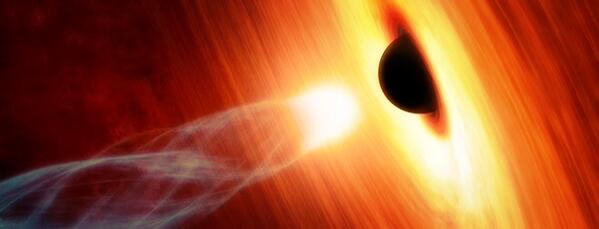
It's believed that when the Big Bang occurred some 14 billion years ago that equal amounts of positive and negative energy were produced. But where positive energy is readily observable in the world around us, negative energy is not. This is because negative energy does not exist in non-vacuum conditions. Introduce a vacuum, however, and you'll not only find negative energy present, but also that positive energy seems to have gone missing.
Stephen Hawking uses the following analogy to describe the existence of negative energy: Imagine a man with a shovel digs a hole. As dirt is shoveled out of the hole, it is made into a pile on the surface. Once the man is finished, he is left with a hole and a mound that perfectly balance each other out. Such is the case with positive and negative energy.
Hawking's analogy applies to the creation of our universe as well, which supposedly was created from nothing. Since the Big Bang produced equal amounts of positive and negative energy, something was created from nothing; take the sum of those two amounts and you're left with 0.
So what exactly is negative energy?
It's not antimatter, which has positive energy. For example, an electron with a positive charge, or positron, is considered anti-matter.
It's also not dark energy, which is thought to make up 68.3% of the universe's mass (on a mass-energy equivalence basis).
Negative energy is perhaps something stranger. Described as "the inherent fluctuations in energy that exists in any energy or magnetic field," negative energy is referred to as a form of "exotic matter." As a concept, negative energy was first proposed in 1928 by British physicist Paul Adrien Maurice Didec. Negative energy was a component of his formula, the Dirac equation, which held that quantum states of positive and negative energy were in balance with one another. In a non-vacuum environment (like here inside our planet's atmosphere), negative energy is not observable. However, inside a vacuum, negative energy is present while positive energy is not.

In 1948, the Dutch physicist Hendrick Casimir predicted that a small attractive force could exist between two uncharged, parallel plates in a vacuum. Should the plates be resting extremely close to one another, negative energy is produced since the number of electromagnetic waves between the two plates becomes less than that of surrounding space. In essence, a negative state of energy becomes present when the wavelengths of particles in a certain region of space are less than what may normally be measured.
Negative energy has been produced in a lab via what's called the Casimir effect. This phenomenon revolves around the idea that vacuum, contrary to its portrayal in classical physics, isn't empty. According to quantum theory, vacuum is full of electromagnetic fluctuations. Distorting these fluctuations can create negative energy.
An interesting phenomenon observed within a negative energy vacuum is that light actually travels faster than it does in a normal vacuum. This has fueled interest in the application of negative energy fields to theories involving FTL travel. Further interest in this area has been fueled by experiments demonstrating that negative energy can distort space-time. In regions of extreme space-time curvature, the existence of negative energy may someday allow for the creation of sustainable wormholes.
It is theorized that negative energy that 'falls back into' a black hole has the effect of lowering the black hole's total mass. In effect, as more and more negative energy falls back into the black hole it will diminish over time, evaporating until nothing is left. This is contrary to the belief that black holes gain in mass indefinitely (or at least until the entire universe has been swallowed).
Conclusion
Negative energy is only one of an assortment of strange phenomenon of which we still do not know enough about. I have my own theories on negative energy, however, and how it might fit into our universe. More precisely, I have ideas on how it fits into the world of my fiction.
Different forms of energy (made-up or not) have already played a major role in some of my writing. For example, in The Alchemancer series, elemental energy plays a substantial role in the story. Negative energy has also made an appearance, though in somewhat subtle fashion as in when Aaron turns his encorder on Ensel Rhe to discover that the eslar's life force signature is negative. Negative energy will play a larger role moving forward into the next book, The Inversion Solution.
Also, negative energy is coming into play in the Assassin Without a Name series. Look for its specific mention in The Goddard Affair, set for release on June 4, 2014. It's already made an appearance in Night of Zealotry, the 3rd assassin tale in the series, when the Jakaree activated their mysterious black energy machine.
Negative energy, as well as other exotic, similar types, will continue to play a role in my fiction. I hope you enjoyed this brief primer.
References

Join today to receive an email when I have a new release available or when I'm taking part in a mega-sale where you can get some great book deals.